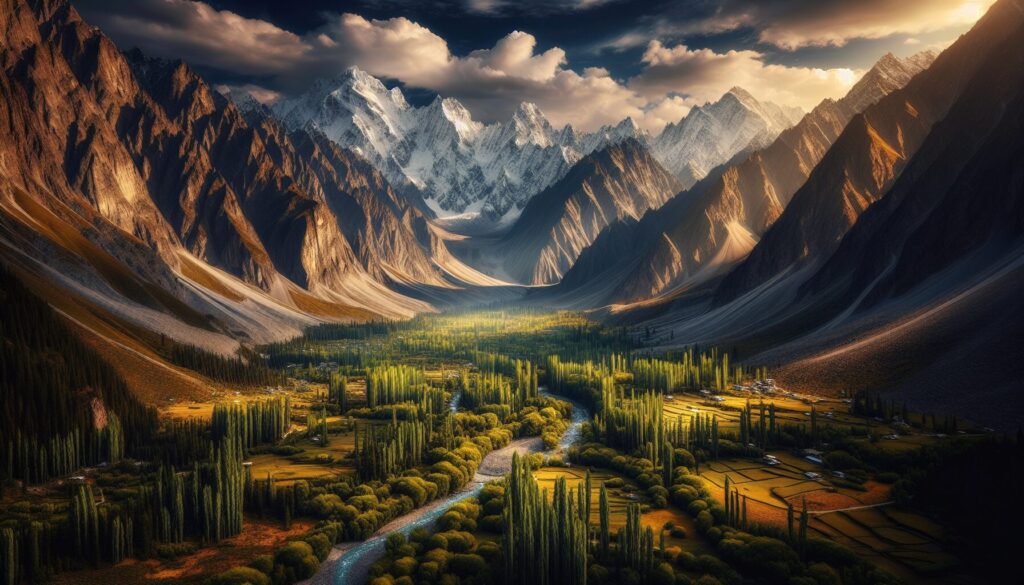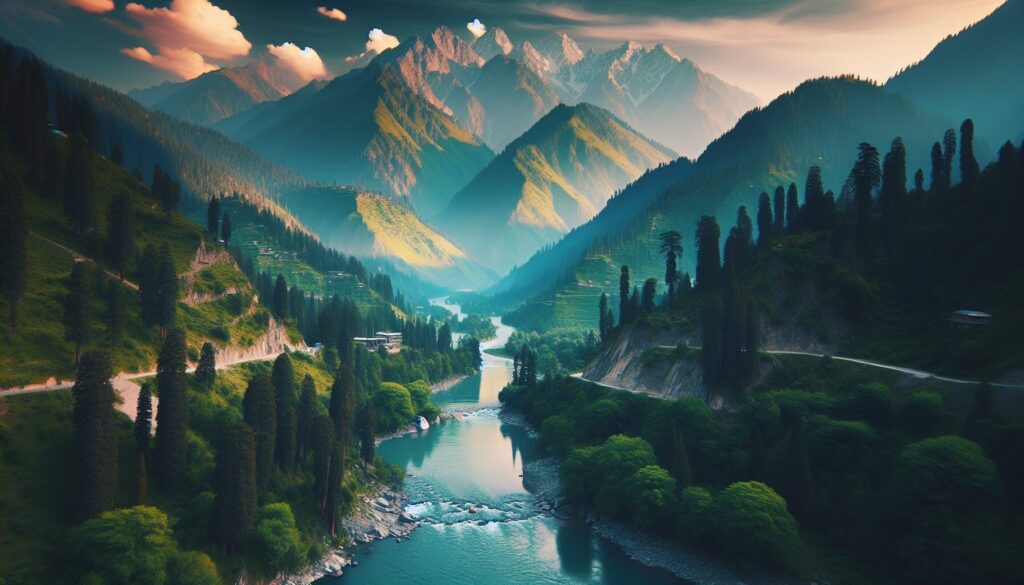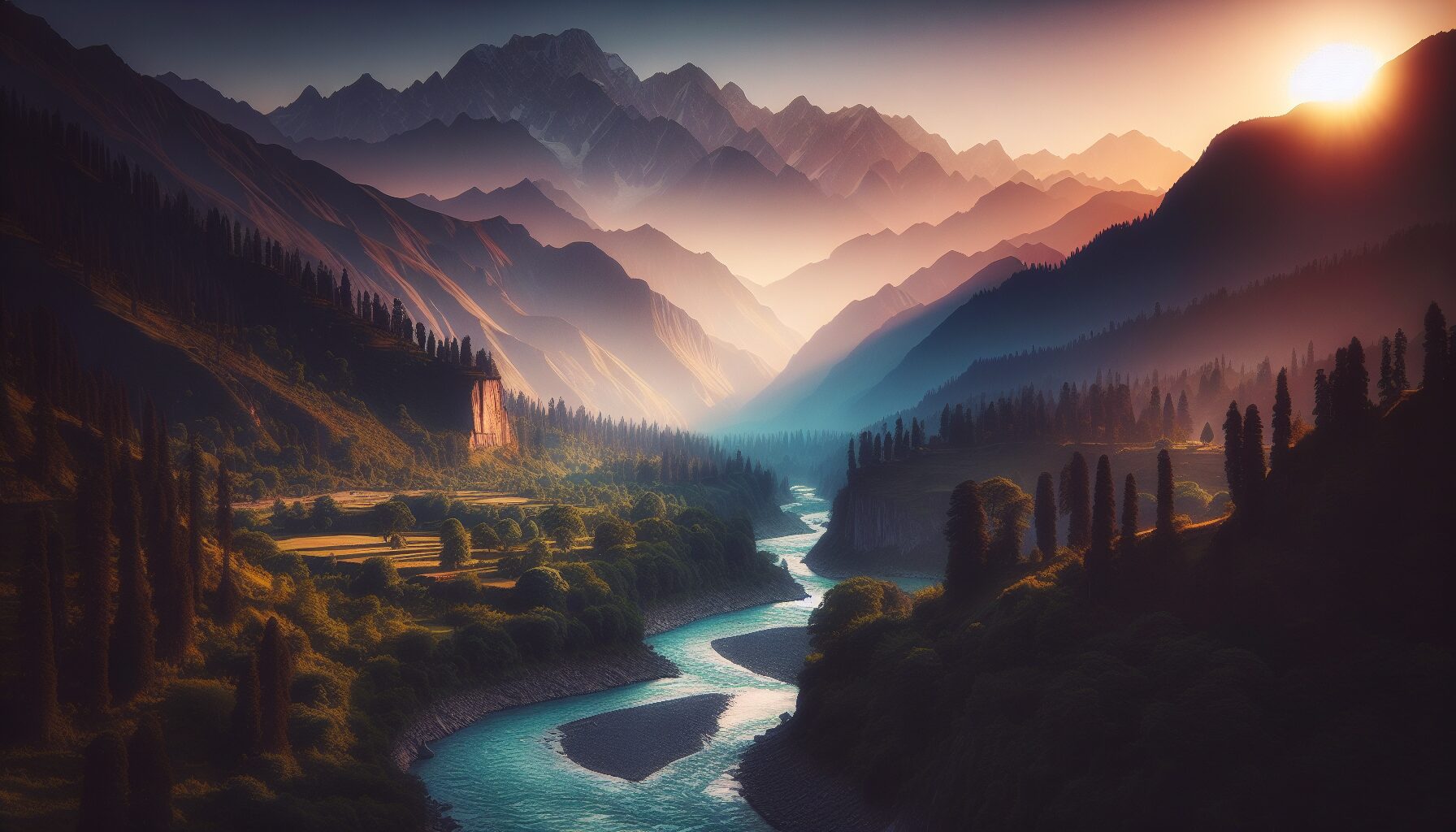Natural light photography is an art form that captures the beauty of the world without artificial lighting. In Pakistan, this approach allows photographers to harness the country’s unique sunlight and diverse landscapes. As an experienced photographer, I’ve found that using a Canon EOS R5 paired with a 50mm f/1.8 lens delivers stunning results. For instance, shooting early in the morning or late afternoon provides soft, golden light. This enhances the natural textures of the environment. I often set my camera to ISO 100 with an aperture of f/8 to ensure sharp, well-exposed images. Additionally, a polarizing filter helps reduce glare, especially when photographing near water bodies like Lake Saif-ul-Malook. These techniques are invaluable when exploring Pakistan’s scenic locations. Moreover, understanding how light interacts with the environment, such as the dramatic shadows cast by mountains, can elevate your photography to a professional level. Organizations like Pakistan Photographers Club offer valuable resources for aspiring photographers.
Related: Natural Light Photography: A Deep Dive Into Techniques
Why Pakistan is Ideal for Photography
Pakistan offers a diverse range of landscapes for natural light photography, from the rugged peaks of the Karakoram to the serene beaches of the Arabian Sea. The country’s varied geography provides photographers with the perfect backdrop for capturing stunning images. During my last visit to the Hunza Valley, I used a Canon EOS R5 paired with a 50mm f/1.8 lens. The valley’s natural light at dawn created striking contrasts, allowing for breathtaking shots even at an ISO setting of 100.
Additionally, Pakistan’s cultural richness adds an extra layer of depth to photography. Cities like Lahore and Karachi are bustling with vibrant street life. The colorful bazaars and historic architecture provide endless opportunities for capturing dynamic images. For instance, using a wide-angle lens in Lahore’s Walled City can capture the intricate details of Mughal architecture. It’s advisable to keep the aperture around f/16 to ensure sharpness throughout the frame.
Perfect Timing and Techniques
Timing is crucial in natural light photography. Early mornings and late afternoons offer the best lighting conditions, known as the golden hour. This is when the sunlight is soft and diffused, casting a warm glow over the landscape. A polarizing filter can be a game-changer, especially when shooting in the mountainous regions. It enhances the colors and reduces glare, particularly useful in places like Deosai National Park.
Moreover, Pakistan’s weather patterns can present unique challenges and opportunities. The monsoon season in the north brings dramatic clouds and vibrant greenery. It’s essential to adjust settings accordingly. Using a tripod for stability during low-light conditions is beneficial, especially when experimenting with slower shutter speeds. Places like the Pakistan Meteorological Department provide valuable weather updates to help plan shoots effectively. By understanding these elements, photographers can make the most out of natural light photography in Pakistan.
1. Hunza Valley

Hunza Valley, nestled in the remarkable Karakoram Range, is a paradise for photographers seeking the perfect natural light. With its stunning landscapes, the valley offers a unique setting. I once visited with my Canon EOS R5 and a 24-70mm f/2.8 lens, ideal for capturing both wide landscapes and detailed shots. The morning light here is enchanting, casting a golden hue across the snow-capped peaks. Shooting at an ISO of 100, f/11, and 1/60s allowed me to capture these breathtaking vistas with clarity.
Additionally, Hunza’s terraced fields and stone-walled villages present countless opportunities for portrait photography. Using a 50mm f/1.8 lens, I found that setting the aperture wide open at f/1.8 created stunning background blur, isolating the subject beautifully against the vibrant landscape. It’s crucial to adjust the white balance manually in this setting, ensuring accurate color representation.
Best Time for Photography
For those planning a visit, autumn is particularly spectacular. The valley is awash with the colors of fall, offering a picturesque backdrop for any shoot. During this time, the lighting is softer, providing a natural diffuser effect. The Hunza River, reflecting the soft light, makes for mesmerizing compositions. A polarizing filter enhances the blue of the sky and reduces glare from the water, perfect for midday shoots when the sun is higher.
Hunza Valley is not only about landscapes. The local culture and people add depth to your portfolio. Capturing the warm smiles of the locals, especially during festivals, adds an authentic touch. Organizations like Pakistan Tourism Development Corporation offer insights into cultural events, enhancing your photographic journey. According to National Geographic, Hunza is one of the top destinations for nature enthusiasts worldwide. Exploring this gem in Pakistan guarantees an unforgettable experience with natural light photography.
2. Skardu
Skardu, nestled in the heart of Gilgit-Baltistan, offers a breathtaking sanctuary for photographers seeking natural light. Its rugged mountains and reflective lakes create a perfect backdrop. On my last visit, I brought along my Canon EOS R5, paired with a 24-70mm f/2.8 lens. This combination is ideal for capturing wide landscapes and detailed close-ups without changing lenses.
The Deosai National Park, known as the Land of Giants, is a must-visit. Here, I used a polarizing filter to enhance the vivid blues of the sky and reduce glare from the water surfaces. Shooting at ISO 100 and f/11, I achieved crisp images with balanced exposure. The golden hour transforms Deosai into a photographer’s paradise. The soft light enriches the colors of the vast plains, making it an excellent opportunity to explore golden hour photography techniques.
Capturing the Serenity of Skardu’s Lakes
While in Skardu, the serene Sheosar Lake is another spot you shouldn’t miss. Framed by snow-capped peaks, its mirror-like water is perfect for reflection shots. I recommend shooting early in the morning when the light is soft and the air is still. This is when your chances of capturing the perfect reflection are highest. Use a tripod to keep your camera stable. This allows you to use slower shutter speeds, like 1/15s, for smooth water effects. Additionally, stopping down to f/16 increases depth of field, keeping both the foreground and background sharp.
For those interested in cultural photography, a visit to the historic Skardu Fort is worthwhile. The fort’s ancient architecture against the backdrop of the Karakoram Range is stunning. When I photographed here, I favored a 50mm f/1.8 lens for its ability to isolate subjects and create a beautiful bokeh effect. These techniques will elevate your images beyond the ordinary. Skardu’s unique landscapes and vibrant culture make it a top destination for capturing the essence of natural light in Pakistan. Don’t forget to check out Pakistan Tourism Development Corporation for travel tips and updates.
3. Fairy Meadows
Fairy Meadows is a photographer’s paradise nestled in the northern region of Pakistan. Known for its breathtaking scenery, it offers incredible opportunities for capturing the natural beauty of the Himalayas. The best time to experience this splendor is during the golden hours—just after sunrise or before sunset—when the light bathes the peaks of Nanga Parbat, the world’s ninth-highest mountain. During my last visit, I used a Canon EOS R5 paired with a 24-70mm f/2.8 lens. This combination allowed me to capture the vibrant colors and the contrasting shadows with remarkable clarity.
Setting up your camera is crucial to get the perfect shot. I recommend using an ISO of 100 to keep the images noise-free, especially when photographing the snowy peaks. An aperture of f/11 ensures a deep depth of field, capturing both the foreground and background in sharp focus. Using a shutter speed of around 1/60s worked well for me to balance the exposure without overexposing the highlights.
Essential Gear for Capturing the Landscape
Besides the camera and lens, a sturdy tripod is essential for stability, especially when shooting long exposures. A polarizing filter is also invaluable here. It helps reduce glare from the snow and enhances the blue hues of the sky. When I visited, the filter made a significant difference by adding depth and contrast to the images.
Fairy Meadows is managed by the local community, known as Fairy Meadows Cottages, who ensure that the area remains pristine. They offer basic accommodation facilities, which allow you to stay overnight and capture the night sky filled with countless stars. For those interested in astro-photography, using a wide-angle lens and setting a long exposure can yield stunning results. Remember to pack extra batteries and memory cards, as you’ll want to capture this magical place from every angle.
4. Lahore's Historic Sites
Lahore’s historic sites offer a captivating blend of architecture and light, perfect for photography enthusiasts. The grandeur of Badshahi Mosque and the intricate details of Lahore Fort provide endless opportunities for capturing stunning images. These locations are ideal for showcasing the interplay of natural light and architectural beauty. When I visited the Lahore Fort, I used a Canon EOS R5 paired with a 24-70mm f/2.8 lens. The versatility of this setup allowed me to adapt quickly to changing light conditions, which is essential when shooting in dynamic environments.
Arriving early in the morning, before the crowds, is key to capturing the soft, golden light that bathes the structures. I set my camera to ISO 100, f/16, and 1/30s to ensure the depth of field and sharpness needed for architectural shots. The use of a tripod can further stabilize your camera, especially when working with slower shutter speeds. Additionally, a polarizing filter can help reduce glare and enhance the blue hues of the sky, making the colors pop in your photographs.
Capturing the Essence of Lahore
For more intimate portraits against historical backdrops, consider using a 50mm f/1.8 lens. This lens allows for beautiful bokeh, isolating your subject while maintaining the essence of the location. While walking through the Shalimar Gardens, I found the afternoon light filtering through the trees to be particularly enchanting. Setting my camera to a wider aperture, around f/2.8, created a dreamy effect, perfect for capturing the tranquility of the gardens. Remember, exploring various angles and perspectives can lead to unexpected and compelling compositions.
5. Makran Coastal Highway
The Makran Coastal Highway offers breathtaking views, making it a prime spot for photography enthusiasts seeking natural light. Spanning over 650 kilometers along Pakistan’s southern coast, it connects Karachi to Gwadar, unveiling stunning landscapes at every turn. The combination of rugged cliffs, pristine beaches, and the endless Arabian Sea provides a versatile backdrop for capturing the perfect shot.
During a recent trip, I found that the golden hour here is particularly enchanting. The soft, diffused light enhances the natural beauty of the landscape. I used a Canon EOS R5 with a 24-70mm f/2.8 lens to capture the expansive vistas. Setting my camera to ISO 100 and f/16 allowed for crisp details and vibrant colors. Additionally, using a polarizing filter helped reduce glare from the water, enhancing the depth of the blue hues.
Exploring Hidden Gems
While the highway itself is a marvel, the nearby Hingol National Park is an unmissable detour. Home to unique rock formations and wildlife, it’s a photographer’s dream. Early mornings in the park offer a serene atmosphere, perfect for capturing wildlife in natural light. I recommend using a 70-200mm lens for wildlife shots, ensuring you maintain a respectful distance while achieving detailed images.
Moreover, the Kund Malir Beach, located along the highway, provides an ideal setting for sunset photography. The interplay of light and shadows on the sand during sunset is mesmerizing. By setting my camera to 1/30s shutter speed, I managed to capture the smooth motion of the waves against the shore. Remember to check with Pakistan Tourism Development Corporation for road conditions and safety updates before planning your trip. The Makran Coastal Highway is a testament to Pakistan’s diverse natural beauty, offering endless opportunities for photographers to explore and capture.
6. Swat Valley

Swat Valley, often referred to as the “Switzerland of the East,” is a paradise for photographers. The valley’s breathtaking landscapes offer endless opportunities for capturing stunning images. Early morning is the best time to shoot, as the soft, diffused light enhances the natural beauty. Using a Canon EOS R5 with a 24-70mm f/2.8 lens can yield impressive results. Set your camera to ISO 100, f/8, and a shutter speed of 1/125s for crisp images.
One of my favorite spots is Malam Jabba, famous for its ski resort and panoramic views. The unique play of light and shadow during sunrise is perfect for landscape photography. Consider using a polarizing filter to reduce glare and enhance colors. This technique works wonders, especially when capturing the lush greenery and snow-capped mountains.
Exploring Ancient Ruins
Beyond natural landscapes, Swat Valley is rich in historical sites. The ruins of Butkara Stupa, dating back to the 2nd century BCE, offer a different kind of beauty. Here, the angle of sunlight can dramatically affect your shots. A 50mm f/1.8 lens is ideal for capturing intricate details of these ancient structures. Adjust your settings to ISO 200, f/4, and 1/60s to balance depth of field and sharpness.
For portrait photography, visit the local bazaars. The vibrant colors and lively atmosphere are captivating. Using natural light, focus on capturing candid moments. A wide aperture like f/2.8 will help blur backgrounds and make subjects stand out. Swat Valley’s blend of nature and history makes it a top choice for photography enthusiasts in Pakistan. Don’t miss the chance to explore this gem with your camera. For more information, you can check resources from Pakistan Tourism Development Corporation or Khyber Pakhtunkhwa Tourism Department.
7. Badshahi Mosque
Badshahi Mosque is a splendid site for capturing the essence of Lahore through the lens. Built during the Mughal era, its grand architecture and intricate details offer a rich canvas for photography enthusiasts. When I visited, I used a Canon EOS R5 paired with a 24-70mm f/2.8 lens. This combination allowed me to capture both wide-angle shots and detailed close-ups. The mosque’s red sandstone facade absorbs sunlight beautifully, especially during the golden hour, providing a warm glow that enhances image depth.
For those interested in capturing the mosque’s majestic exterior, an early morning session is ideal. The soft morning light adds a gentle touch, minimizing harsh shadows. I set my camera to ISO 100, f/16, and a shutter speed of 1/30s to ensure sharpness while maintaining a balanced exposure. A circular polarizing filter can help manage reflections and enhance the blue sky, making the architecture pop against the background.
Capturing Intricate Interior Details
Inside the mosque, natural light filters through the high ceilings and archways, creating a mesmerizing play of light and shadow. Here, a 50mm f/1.8 lens can be incredibly useful for focusing on detailed carvings and calligraphy. I found that setting the aperture to f/2.8 allowed for a shallow depth of field, highlighting intricate patterns while softly blurring the background. It’s important to be respectful, as this is a place of worship, so move quietly and avoid using flash.
Moreover, engaging with the local community can enhance your experience. The caretakers often share fascinating stories about the mosque’s history. They add a personal touch to your visit, enriching your understanding and appreciation. Lastly, don’t forget to explore nearby attractions like the Lahore Fort and Shalimar Gardens, which also offer stunning opportunities for natural light photography.
Conclusion
In essence, the diverse landscapes and unique light conditions of Pakistan make it an ideal destination for natural light photography. From the captivating peaks of the Karakoram in Hunza Valley to the serene beaches along the Makran Coastal Highway, each location offers photographers a unique canvas to capture stunning images. Utilizing tools like the Canon EOS R5 and lenses such as the 50mm f/1.8 or 24-70mm f/2.8, along with techniques like using polarizing filters and adjusting settings for golden hour, photographers can create breathtaking compositions. The rich cultural tapestry in cities like Lahore further enhances photographic opportunities, while the natural wonders of Skardu, Fairy Meadows, and Swat Valley offer additional avenues for exploration. By understanding the interplay of light and landscape, photographers can elevate their craft and capture the true essence of Pakistan’s beauty. Happy shooting!
Continue Exploring
Unlock the secrets to capturing genuine moments with natural light photography. Dive into how this technique enhances authenticity and transforms your images into true storytelling masterpieces.
Frequently Asked Questions
What are the best times of day for natural light photography in Pakistan?
The best times for natural light photography in Pakistan are during the ‘golden hours,’ which occur shortly after sunrise and just before sunset. During these times, the sunlight is softer and warmer, creating ideal conditions for capturing stunning photographs.
How can I enhance my natural light photography skills in Pakistan's diverse landscapes?
To enhance your natural light photography skills in Pakistan, start by understanding the unique lighting conditions of different landscapes, such as mountains, deserts, and coastlines. Experiment with different angles, shadows, and compositions. Participating in photography workshops and joining local photography groups can also provide valuable insights and feedback.
What equipment is essential for natural light photography in Pakistan?
While natural light photography primarily relies on ambient light, having a good quality camera with manual settings is essential. A tripod can help stabilize your shots, especially in low-light conditions. Additionally, carrying lenses with different focal lengths can provide versatility for capturing various scenes across Pakistan’s diverse locations.


Leave a Reply